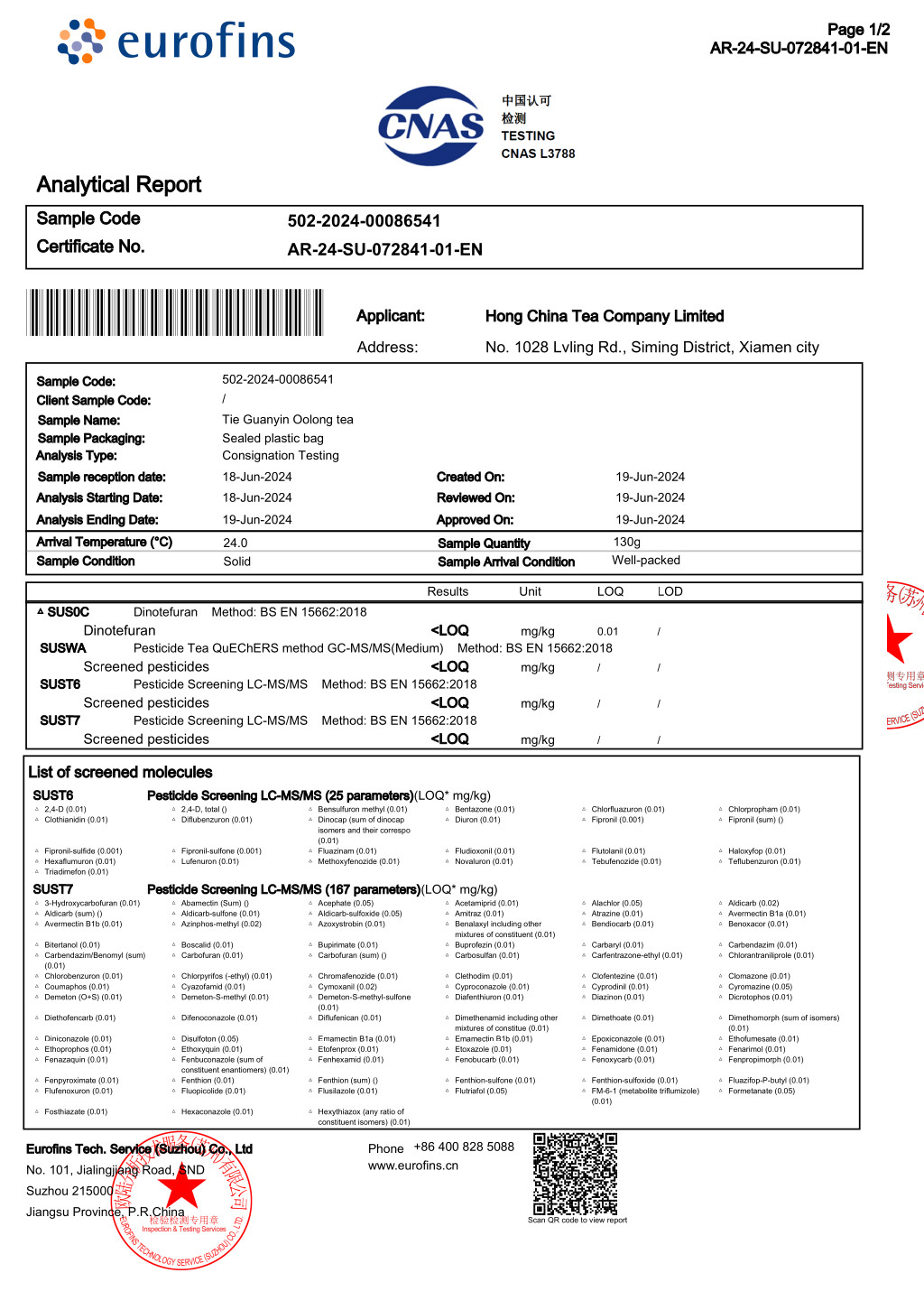As a professional exporter, conquering the Maximum Residue Limit is the first step to offer you teas. EU/UK has different requirements from USA. To us, it’s the same, as what Hong China Tea Company offer is Pesticide Free tea which can conform to any countries’ standard. The tested teas including Tieguanyin, Wuyi Rock tea, Puer, White tea and Black tea even Jasmine tea.
The most challenging tea is definitely Oolong, no matter Tieguanyin or Wuyi Da Hong Pao, as what Oolong requires is mature leaf instead of little buds, growing from buds into leaf needs over 20 days and that long time gives insects chance especially under the also growing temperature, higher temperature means more insects. When the leaf is at the right time for Oolong picking, it’s quite hard to keep it intact when bad guys surrounded.
What could give us a surprise is Anthraquinone and Matrine now. Anthraquinone was a new contaminant, with unknown source, occurred golbally in tea though it is actually not a pesticide. Matrine is an alkaloid isolated from the traditional Chinese medicine Sophora flavescens Aiton, in short it is a natural plant-based insects fighter. Some farmers treat this Matrine as a natural replacement of pesticide in organic practice. But rule is rule, here we are not discussing right or wrong, we are here to find the best solution to conform to rule.
Another point is about testing lab, different lab might have different ability and we have been working with Eurofins for over decades because of its good reputation. SGS is ok too while it is more famous to most consumers, but Eurofins is more famous to tea importers/exporters. At the bottom is an Oolong tea testing report we just recevied this week.
How to get Pesticide Free all the time?
This is a smart question. Actually what you and we want is not a report, what we really want is safe product and not just now but from day one to the last.
Also when you do a testing, the sample you offered could not cover all the tea garden and a tea garden could be very huge, the one you have might just come from some specific regions, then how could you make sure the sample you have can represent the whole tea garden?
Normally I will check 5 aspects:
- Does the tea garden have grass?
- Is the soil loose or hard?
- Is the leaf yellow green or dark green?
- What the pickers say about it?
- What the owner’s neighbors say about it?
If everything is ok, it means Pesticide Free is not just an order, it’s an idea that has been accepted by all employees and the whole community. Everything can flash out, only great thoughts can survive.
EU Pesticides database
The European Commission has published all the pesticde residues on the website, but be aware sometimes the authority will check something new which is not listed on this following database, so be sure to keep an eye on the European Parliament news as well as SPS & TBT Platform of WT.
Also the Rapd Alert System for Food and Feed (RASFF) has a searchable database called RASFF Window that you can see what troubles why one tea is refused to be imported in.
And remember, if it’s not found there, it would be the default 0.01ppm.
Europe Pesticide Residues database
What EU compliant teas we have?
The tea list is long and updated regularly, in short the catalog includes Black tea, Green tea, Oolong tea, Yunnan Puer, White tea and experimental Yellow tea, they comes from Yunnan, Guangdong, Fujian, Guangxi, Zhejiang, Sichuan etc, of all the teas we make 35% by ourself and outsource the rest. Almost every year we do tea experiments and thus to have shiny new tea which is different from the ones in the market.
The teas we created normally have the following characters:
- Zero astringency
- Hight aroma
- Full body
It’s unique enough to get you stand out and earn the extra profit, as we know in the end the winner is always the one impressed.
The followings are some teas we are proud of though not full list.
- Fullaroma Winter Dan Cong Oolong tea - EU organic certified with rebellious aroma
- Fruitymore black tea - A gift from mysterious tribes of Yunnan and Zero astringency
- Peach Heart Oolong tea - Rock tea with charming natural peach aroma
- Right Heart White tea - A combination of elegance mixed with power
- Great General Green tea - Five stars body
And sure, don’t forget the Chinese Matcha made by Long Jing 43, you know this special cultivar right?
